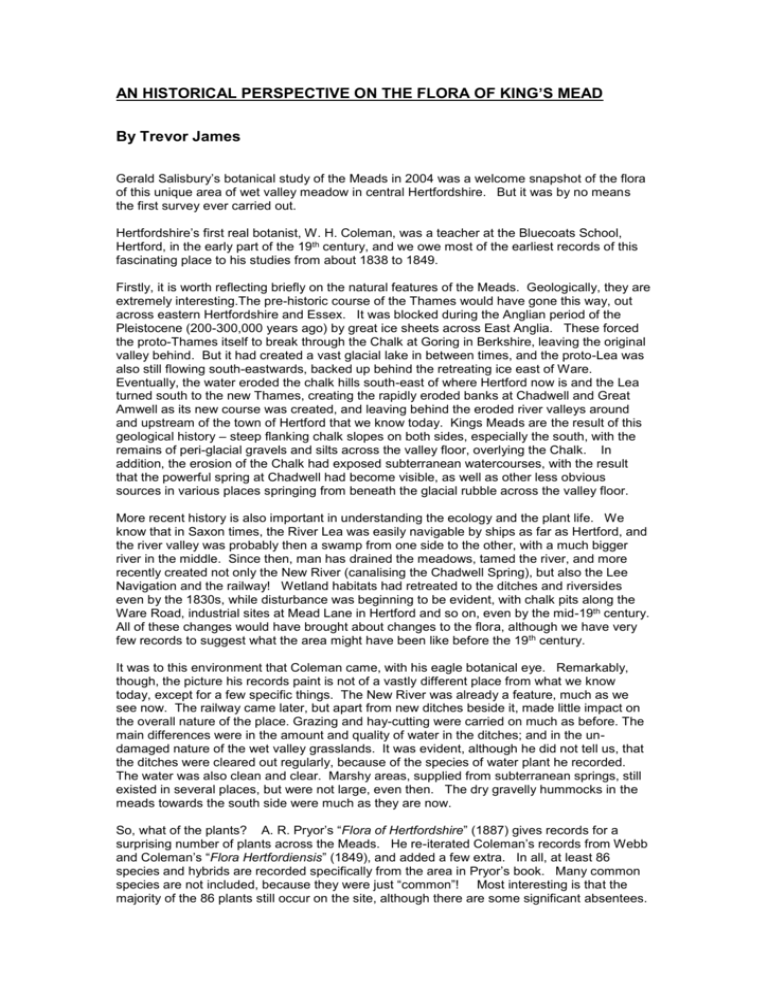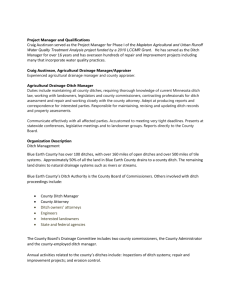an historical perspective on the flora of king`s mead
advertisement

AN HISTORICAL PERSPECTIVE ON THE FLORA OF KING’S MEAD By Trevor James Gerald Salisbury’s botanical study of the Meads in 2004 was a welcome snapshot of the flora of this unique area of wet valley meadow in central Hertfordshire. But it was by no means the first survey ever carried out. Hertfordshire’s first real botanist, W. H. Coleman, was a teacher at the Bluecoats School, Hertford, in the early part of the 19th century, and we owe most of the earliest records of this fascinating place to his studies from about 1838 to 1849. Firstly, it is worth reflecting briefly on the natural features of the Meads. Geologically, they are extremely interesting.The pre-historic course of the Thames would have gone this way, out across eastern Hertfordshire and Essex. It was blocked during the Anglian period of the Pleistocene (200-300,000 years ago) by great ice sheets across East Anglia. These forced the proto-Thames itself to break through the Chalk at Goring in Berkshire, leaving the original valley behind. But it had created a vast glacial lake in between times, and the proto-Lea was also still flowing south-eastwards, backed up behind the retreating ice east of Ware. Eventually, the water eroded the chalk hills south-east of where Hertford now is and the Lea turned south to the new Thames, creating the rapidly eroded banks at Chadwell and Great Amwell as its new course was created, and leaving behind the eroded river valleys around and upstream of the town of Hertford that we know today. Kings Meads are the result of this geological history – steep flanking chalk slopes on both sides, especially the south, with the remains of peri-glacial gravels and silts across the valley floor, overlying the Chalk. In addition, the erosion of the Chalk had exposed subterranean watercourses, with the result that the powerful spring at Chadwell had become visible, as well as other less obvious sources in various places springing from beneath the glacial rubble across the valley floor. More recent history is also important in understanding the ecology and the plant life. We know that in Saxon times, the River Lea was easily navigable by ships as far as Hertford, and the river valley was probably then a swamp from one side to the other, with a much bigger river in the middle. Since then, man has drained the meadows, tamed the river, and more recently created not only the New River (canalising the Chadwell Spring), but also the Lee Navigation and the railway! Wetland habitats had retreated to the ditches and riversides even by the 1830s, while disturbance was beginning to be evident, with chalk pits along the Ware Road, industrial sites at Mead Lane in Hertford and so on, even by the mid-19th century. All of these changes would have brought about changes to the flora, although we have very few records to suggest what the area might have been like before the 19th century. It was to this environment that Coleman came, with his eagle botanical eye. Remarkably, though, the picture his records paint is not of a vastly different place from what we know today, except for a few specific things. The New River was already a feature, much as we see now. The railway came later, but apart from new ditches beside it, made little impact on the overall nature of the place. Grazing and hay-cutting were carried on much as before. The main differences were in the amount and quality of water in the ditches; and in the undamaged nature of the wet valley grasslands. It was evident, although he did not tell us, that the ditches were cleared out regularly, because of the species of water plant he recorded. The water was also clean and clear. Marshy areas, supplied from subterranean springs, still existed in several places, but were not large, even then. The dry gravelly hummocks in the meads towards the south side were much as they are now. So, what of the plants? A. R. Pryor’s “Flora of Hertfordshire” (1887) gives records for a surprising number of plants across the Meads. He re-iterated Coleman’s records from Webb and Coleman’s “Flora Hertfordiensis” (1849), and added a few extra. In all, at least 86 species and hybrids are recorded specifically from the area in Pryor’s book. Many common species are not included, because they were just “common”! Most interesting is that the majority of the 86 plants still occur on the site, although there are some significant absentees. Since the 1880’s, botanical exploration of the Hertford area was probably not as thorough as it might have been. John Dony, in his “Flora of Hertfordshire” (1967), did not make a special effort to record the area, with the result that some species known to Coleman were not refound until recently. However, during survey work between 1989 and 1994 for the next ‘Flora of Hertfordshire’ currently being written, much more attention was paid to different areas of the site, so that many plants were re-discovered. A detailed study was also carried out of the sad remains of the ditch system prior to the site being made a nature reserve, which added some other records. Taking all these records together, some of the most interesting changes have been in the loss of pondweeds etc. from the ditch system, and also of certain species from unimproved grassland and wetlands that were evidently damaged by weed-killer sprays or other management during the 1950s or earlier. Particularly sad losses are the Green-winged Orchids Orchis morio, which were particularly abundant in the 19th century; Southern Marsh Orchids Dactylorhiza praetermissa “in a marshy part of the Kings Meads near Chadwell”; and Marsh Lousewort Pedicularis palustris (otherwise known as Red Rattle), which used to occur in “drains in the meads near Little Amwell, between Hertford and Ware”, and which is now extinct in Herts. altogether! The missing pondweeds are instructive: Potamogeton lucens, and P. perfoliatus in the river Lea; P. crispus and P. pusillus in the ditches, the last especially being noted as “plentiful”. All of these need clean, unpolluted water. Our chalk water nowadays is becoming enriched from fertiliser run-off everywhere, so that these sorts of plants are vanishing. Other plants that appear no longer to occur include Mare’s-tail Hippuris vulgaris, which used to occur in the Manifold Ditch etc.; Marsh Willowherb Epilobium palustre, also in the ditches; Fan-leaved Water-crowfoot Ranunculus circinatus, a casualty of ditch loss (as well as indicating just how deep they must have been!); Crosswort Cruciata laevipes, which used to grow “near Chadwell”; Marsh Valerian Valeriana dioica in “marshes at Chadwell”; Changing Forget-me-not Myosotis discolor “on dry knolls in the meads”; Flowering Rush Butomus umbellatus in the Manifold Ditch; Narrow-leaved Water-plantain Alisma lanceolatum, which was “scarce” even in the 19th century; Arrowhead Sagittaria sagittifolia, a casualty of ditch loss as well as pollution of the River Lea itself; Marsh Arrowgrass Triglochin palustre, lost from marshy ground “near Chadwell”; and Meadow Brome Bromus racemosus, which was obviously once quite common. The historic records also give us one or two other interesting observations. There is one record of Early Marsh Orchid Dactylorhiza incarnata. This was always rare in Herts., and is usually associated with calcium-rich spring sources in old pastures. It was recorded at Kings Meads in 1840, but not since, although it is now very much a feature of artificial mineral-rich substrates on old fly-ash elsewhere in the Lea Valley. Another nice record is of Cow Parsley Anthriscus sylvestris. Coleman obviously thought it worth recording that it grew in the meads between Hertford and Ware, suggesting it was not that frequent elsewhere! It is now one of the County’s most ubiquitous roadside weeds! There are a special series of old records from the chalky banks above Chadwell Spring, which were well-known to earlier botanists. Many plants still found there include Autumn Felwort Gentianella amarella, Kidney Vetch Anthyllis vulneraria, Pyramidal Orchid Anacamptis pyramidalis; Small Scabious Scabiosa columbaria, Marjoram Origanum vulgare and Rockrose Helianthemum nummularium, all of which have been recorded since 1987. Interestingly, there was specifically no record of Clustered Bellflower Campanula glomerata in the 19th century, which does now occur here sporadically, although it used to occur on banks the other side of the road on what is now the golf course! The Chadwell banks, though, have lost one or two special plants: Fragrant Orchid Gymnadenia conopsea and Horseshoe Vetch Hippocrepis comosa, scarce plants of old chalk grassland, both appear to have vanished, although the latter was hanging on by the side of the Ware Road nearby as late as 1988. Just a few plants that were recorded in the 19th century and which were not recorded in the 2004 survey, have in fact been recorded fairly recently. Tubular Water Dropwort Oenanthe fistulosa is one. This is an interesting plant in the list for the Meads, because it is usually (now rather rarely) found in slightly acidic upland ponds. However, it was noted by Coleman as being in “ditches near Chadwell” in the 19th century, and it was by the causeway here that I saw it in 1978, although the permanent flooding of the marsh here now has probably destroyed this (and other plants) which need to have naturally flushed wetlands, rather than stagnant water. Bistort Persicaria bistorta is another. It was found in the grassland on the banks of the New River in 1992, and Coleman knew it in “three distinct and large patches in the meads between Hertford Lock and the New River Company’s engine house”. It is probably still there. The flora of Kings Meads, therefore, is one both of survival, and of change, much like the rest of the County. The natural features are important: the chalky banks and their ancient downland flora, miles away from any other chalk downland habitat; the remnants of natural marshland flora, especially where natural flushing from subterranean aquifers are allowed to maintain their function; and the remnants of aquatic habitats. Uncommon plants still occur, such as the Graceful Sedge Carex acuta by at least one ditch; or the beautiful Meadow Saxifrage Saxifraga granulata, which occurs on the humps in the southern mead, as well as by the New River. Grazing is vital for the continuation of much of the flora, and perhaps, with time, some of the apparently “missing” plants will reappear. Clearance and maintenance of the valuable ditch systems would aid the survival or re-appearance of aquatic flora (and other wildlife). What is certain though is that new species will arrive, like the sudden appearance of hundreds of Adder’s-tongue Fern Ophioglossum vulgatum fronds in a grazed meadow north of the New River in 1994, never having been seen there before. Continued and repeated recording remains vital to monitor these changes.











